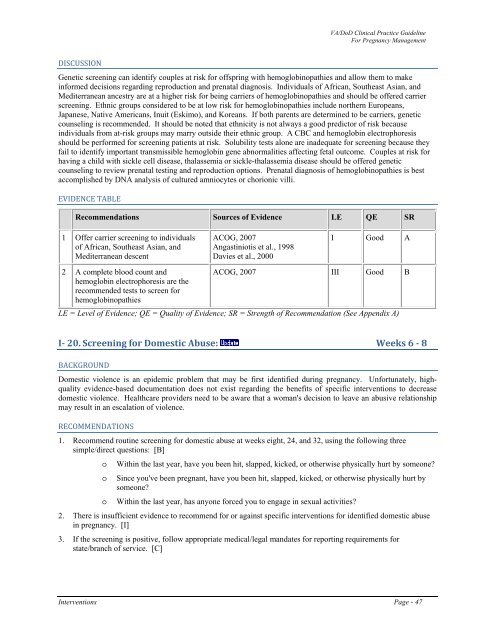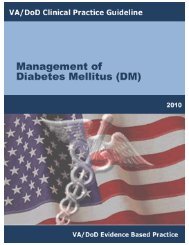Management of pregnancy - VA/DoD Clinical Practice Guidelines ...
Management of pregnancy - VA/DoD Clinical Practice Guidelines ...
Management of pregnancy - VA/DoD Clinical Practice Guidelines ...
You also want an ePaper? Increase the reach of your titles
YUMPU automatically turns print PDFs into web optimized ePapers that Google loves.
<strong>VA</strong>/<strong>DoD</strong> <strong>Clinical</strong> <strong>Practice</strong> Guideline<br />
For Pregnancy <strong>Management</strong><br />
DISCUSSION<br />
Genetic screening can identify couples at risk for <strong>of</strong>fspring with hemoglobinopathies and allow them to make<br />
informed decisions regarding reproduction and prenatal diagnosis. Individuals <strong>of</strong> African, Southeast Asian, and<br />
Mediterranean ancestry are at a higher risk for being carriers <strong>of</strong> hemoglobinopathies and should be <strong>of</strong>fered carrier<br />
screening. Ethnic groups considered to be at low risk for hemoglobinopathies include northern Europeans,<br />
Japanese, Native Americans, Inuit (Eskimo), and Koreans. If both parents are determined to be carriers, genetic<br />
counseling is recommended. It should be noted that ethnicity is not always a good predictor <strong>of</strong> risk because<br />
individuals from at-risk groups may marry outside their ethnic group. A CBC and hemoglobin electrophoresis<br />
should be performed for screening patients at risk. Solubility tests alone are inadequate for screening because they<br />
fail to identify important transmissible hemoglobin gene abnormalities affecting fetal outcome. Couples at risk for<br />
having a child with sickle cell disease, thalassemia or sickle-thalassemia disease should be <strong>of</strong>fered genetic<br />
counseling to review prenatal testing and reproduction options. Prenatal diagnosis <strong>of</strong> hemoglobinopathies is best<br />
accomplished by DNA analysis <strong>of</strong> cultured amniocytes or chorionic villi.<br />
EVIDENCE TABLE<br />
Recommendations Sources <strong>of</strong> Evidence LE QE SR<br />
1 Offer carrier screening to individuals<br />
<strong>of</strong> African, Southeast Asian, and<br />
Mediterranean descent<br />
ACOG, 2007<br />
Angastiniotis et al., 1998<br />
Davies et al., 2000<br />
I Good A<br />
2 A complete blood count and<br />
ACOG, 2007 III Good B<br />
hemoglobin electrophoresis are the<br />
recommended tests to screen for<br />
hemoglobinopathies<br />
LE = Level <strong>of</strong> Evidence; QE = Quality <strong>of</strong> Evidence; SR = Strength <strong>of</strong> Recommendation (See Appendix A)<br />
I 20. Screening for Domestic Abuse: Weeks 6 8<br />
BACKGROUND<br />
Domestic violence is an epidemic problem that may be first identified during <strong>pregnancy</strong>. Unfortunately, highquality<br />
evidence-based documentation does not exist regarding the benefits <strong>of</strong> specific interventions to decrease<br />
domestic violence. Healthcare providers need to be aware that a woman's decision to leave an abusive relationship<br />
may result in an escalation <strong>of</strong> violence.<br />
RECOMMENDATIONS<br />
1. Recommend routine screening for domestic abuse at weeks eight, 24, and 32, using the following three<br />
simple/direct questions: [B]<br />
o Within the last year, have you been hit, slapped, kicked, or otherwise physically hurt by someone?<br />
o Since you've been pregnant, have you been hit, slapped, kicked, or otherwise physically hurt by<br />
someone?<br />
2.<br />
3.<br />
o<br />
Within the last year, has anyone forced you to engage in sexual activities?<br />
There is insufficient evidence to recommend for or against specific interventions for identified domestic abuse<br />
in <strong>pregnancy</strong>. [I]<br />
If the screening is positive, follow appropriate medical/legal mandates for reporting requirements for<br />
state/branch <strong>of</strong> service. [C]<br />
Interventions Page - 47
















